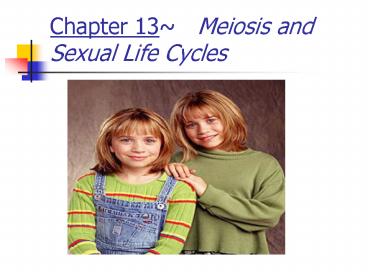Chapter 13Meiosis and Sexual Life Cycles - PowerPoint PPT Presentation
1 / 16
Title:
Chapter 13Meiosis and Sexual Life Cycles
Description:
... (46); 1 pair of sex and 22 pairs of autosomes; karyotype; ... Meiosis: cell division to produce haploid gametes. Karyotype. Alternative life cycles I ... – PowerPoint PPT presentation
Number of Views:98
Avg rating:3.0/5.0
Title: Chapter 13Meiosis and Sexual Life Cycles
1
Chapter 13 Meiosis and Sexual Life Cycles
2
Heredity
- Heredity the transmission of traits from one
generation to the next - Asexual reproduction clones
- Sexual reproduction variation
- Human life cycle 23
pairs of homologous chromosomes (46)
1 pair of sex and 22 pairs of
autosomes karyotype gametes are
haploid (1N)/ all other cells are diploid
(2N) fertilization (syngamy) results
in a zygote - Meiosis cell division to produce haploid
gametes
3
Karyotype
4
Alternative life cycles I
- Fungi/some algae meiosis produces 1N cells that
divide by mitosis to produce 1N adults (gametes
by mitosis)
5
Alternative life cycles II
- Plants/somealgae
- Alternation of generations 2N sporophyte, by
meiosis, produces 1N spores spore divides by
mitosis to generate a 1N gametophyte gametes
then made by mitosis which then fertilize into 2N
sporophyte
6
Meiosis
- Preceded by chromosome replication, but is
followed by 2 cell divisions (Meiosis I Meiosis
II) - 4 daughter cells 1/2 chromosome number (1N)
variation
7
Meiosis I
- Division in meiosis I occurs in four phases
prophase, metaphase, anaphase, and telophase. - During the preceding interphase the chromosomes
are replicated to form sister chromatids.
8
Meiosis I
- In prophase I, the chromosomes condense and
homologous chromosomes pair up to form tetrads. - In a process called synapsis, special proteins
attach homologous chromosomes tightly together. - At several sites the chromatids of homologous
chromosomes are crossed (chiasmata) and segments
of the chromosomes are traded.
9
Meiosis I
- At metaphase I, the tetrads are all arranged at
the metaphase plate. - In anaphase I, the homologous chromosomes
separate and are pulled toward opposite poles.
10
Meiosis I
- In telophase I, movement of homologous
chromosomes continues until there is a haploid
set at each pole. - Cytokinesis by the same mechanisms as mitosis
usually occurs simultaneously
11
Meiosis II
- very similar to mitosis
- During prophase II a spindle apparatus forms,
attaches to kinetochores of each sister
chromatids, and moves them around.
12
Meiosis II
- At metaphase II, the sister chromatids are
arranged at the metaphase plate. - At anaphase II, the centomeres of sister
chromatids separate and the now separate
sisters travel toward opposite poles.
13
Meiosis II
- In telophase II, separated sister chromatids
arrive at opposite poles - Cytokinesis separates the cytoplasm.
- At the end of meiosis, there are four haploid
daughter cells.
14
Meiosis vs. mitosis
- Synapsis/tetrad/chiasmata (prophase I)
- Homologous vs. individual chromosomes (metaphase
I) - Sister chromatids do not separate (anaphase I)
- Meiosis I separates homologous pairs of
chromosomes, not sister chromatids of individual
chromosomes.
15
Origins of Genetic Variation, I
- Independent assortment homologous pair of
chromosomes position and orient randomly
(metaphase I) and nonidentical sister chromatids
during meiosis II - Combinations possible 2 with n the
haploid number of the organism
16
Origins of Genetic Variation, II
- Crossing over (prophase I) the reciprocal
exchange of genetic material between nonsister
chromatids during synapsis of meiosis I
(recombinant chromosomes) - Random fertilization 1 sperm
(1 of 8 million possible chromosome combinations)
x 1 ovum (1 of 8 million different possibilities)
64 trillion diploid combinations!































